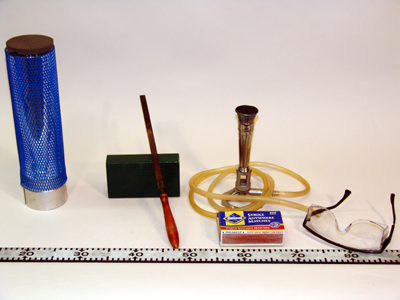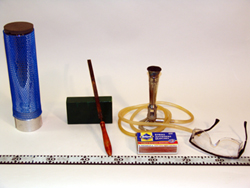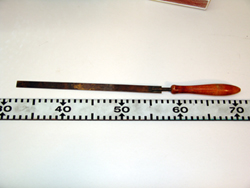|
Size: 1764
Comment:
|
Size: 2082
Comment:
|
| Deletions are marked like this. | Additions are marked like this. |
| Line 2: | Line 2: |
| ||<30% style="text-align:center">[[PiraScheme#Thermodynamics|Table of Thermodynamics Demonstration]] ||<30% style="text-align:center">[[TDEquipmentList|Thermodynamics Equipment List]] ||<30% style="text-align:center">[[Demonstrations|Lecture Demonstrations]] || |
|
| Line 3: | Line 5: |
'''Topic and Concept:''' Thermal Properties of Matter, [[ThermalProperties#SolidExpansion|4A30. Solid Expansion]] |
|
| Line 9: | Line 15: |
| (attachment photo showing the fully set up demonstration) | {{attachment:4A30-10a-01a.jpg}} |
| Line 11: | Line 17: |
| '''Description:''' | '''Abstract:''' |
| Line 17: | Line 23: |
| ||Bimetallic Strip||[:ThermoCabinetBayA3: TD, A3, Shelf #1]|| || | ||Bimetallic Strip||[[ThermoCabinetBayA3| TD, A3, Shelf #1]]|| || |
| Line 23: | Line 29: |
| '''Setup:''' 1. Make sure that you have all apparatuses in the table above. 1. Install the burner gas tube with the gas source. 1. Make sure that you have the gas switch off and in the right pressure that you want before you turn it on. '''Cautions, Warnings, or Safety Concerns:''' 1. Beware of the burner and the liquid nitrogen. |
'''''Important Setup Notes:''''' |
| Line 31: | Line 31: |
| '''Demonstration:''' The bimetallic strip consists of brass and stainless steel. Since brass has higher thermal [http://en.wikipedia.org/wiki/Coefficient_of_thermal_expansion expansion coefficient] than stainless steel. When it is heated by the burner, it bends to the stainless steel side. On the other hand, placed it in liquid nitrogen (77K) the strip bends in opposite which is to the brass side. |
* This demonstration requires a supply of methane gas usually provided by the [[RedWhiteGasCart|red and white gas carts]] found in rooms 2103, 2241, (and 2223 upon request). |
| Line 36: | Line 34: |
| ||attachment other photos||attachment other photos|| ||attachment other photos||attachment other photos|| |
'''Setup and Procedure:''' 1. Make sure that you have all apparatuses in the table above. '''Cautions, Warnings, or Safety Concerns:''' * Beware of the burner and the liquid nitrogen. '''Discussion:''' The bimetallic strip consists of brass and stainless steel. Since brass has higher thermal [[http://en.wikipedia.org/wiki/Coefficient_of_thermal_expansion|expansion coefficient]] than stainless steel. When it is heated by the burner, it bends to the stainless steel side. On the other hand, placed it in liquid nitrogen (77K) the strip bends in opposite which is to the brass side. ||{{attachment:4A30-10a-01i.jpg}}||{{attachment:4A30-10a-03-250.jpg}}|| |
| Line 41: | Line 52: |
| 1. [http://hyperphysics.phy-astr.gsu.edu/hbase/thermo/bimetal.html Hyperphysics] | * [[http://hyperphysics.phy-astr.gsu.edu/hbase/thermo/bimetal.html|Hyperphysics - Bimetalic Strip]] |
| Line 43: | Line 54: |
| [:ThermalProperties:Thermal Properties of Matter] [:Demonstrations:Demonstrations] [:Instructional:Home] |
[[Instructional|Home]] |
Bimetallic Strip, 4A30.10a
Topic and Concept:
Thermal Properties of Matter, 4A30. Solid Expansion
Location:
Cabinet: Thermodynamics Cabinet
Bay: (A3)
Shelf: #1

Abstract:
Insert description of apparatus, its component, what it is demonstrating.
Equipment |
Location |
ID Number |
|
|
|
Bimetallic Strip |
|
|
Burner |
location |
NA |
Liquid nitrogen |
location |
NA |
Safety grove and glasses |
location |
NA |
Important Setup Notes:
This demonstration requires a supply of methane gas usually provided by the red and white gas carts found in rooms 2103, 2241, (and 2223 upon request).
Setup and Procedure:
- Make sure that you have all apparatuses in the table above.
Cautions, Warnings, or Safety Concerns:
- Beware of the burner and the liquid nitrogen.
Discussion:
The bimetallic strip consists of brass and stainless steel. Since brass has higher thermal expansion coefficient than stainless steel. When it is heated by the burner, it bends to the stainless steel side. On the other hand, placed it in liquid nitrogen (77K) the strip bends in opposite which is to the brass side.
|
|
References:

